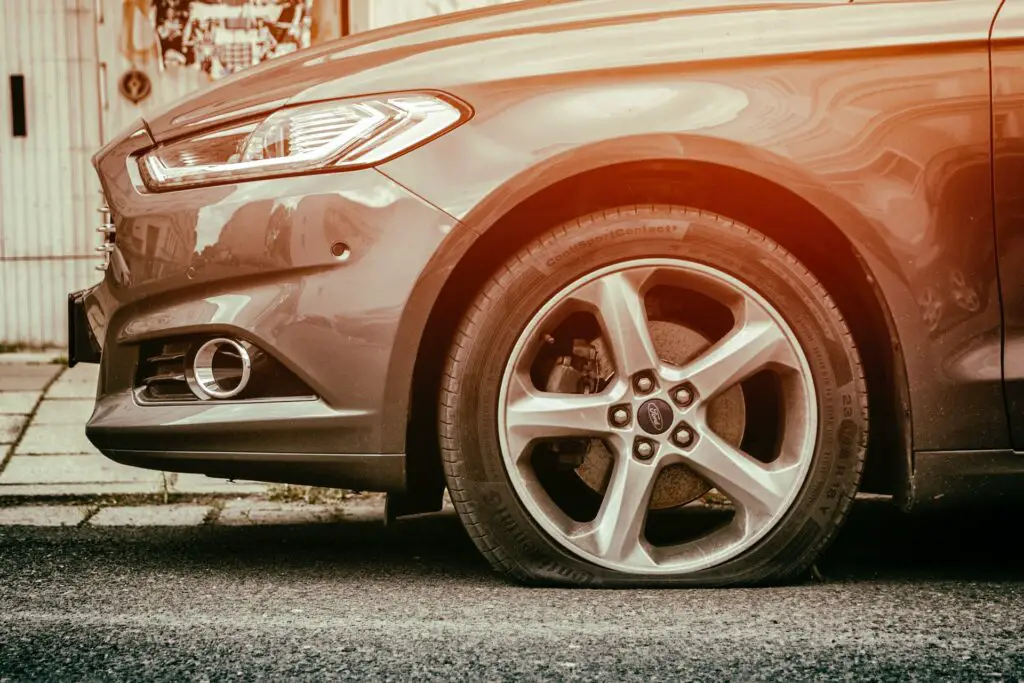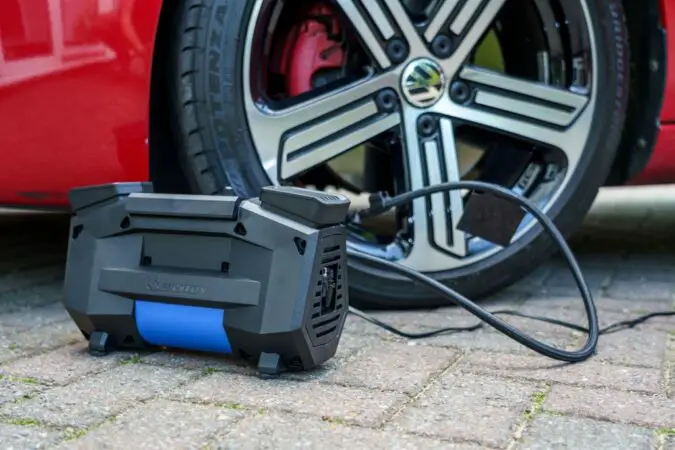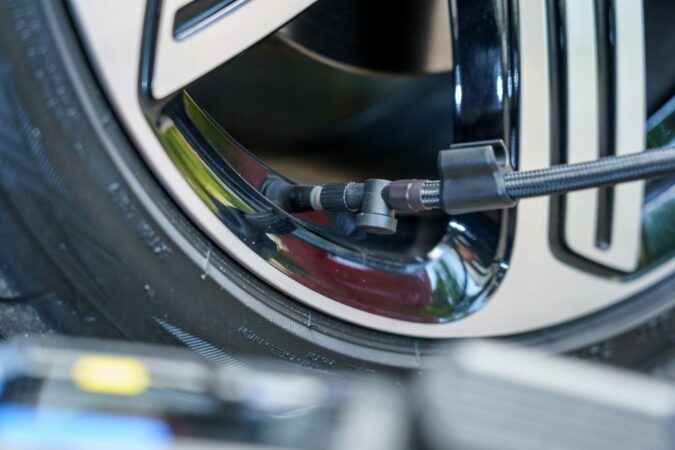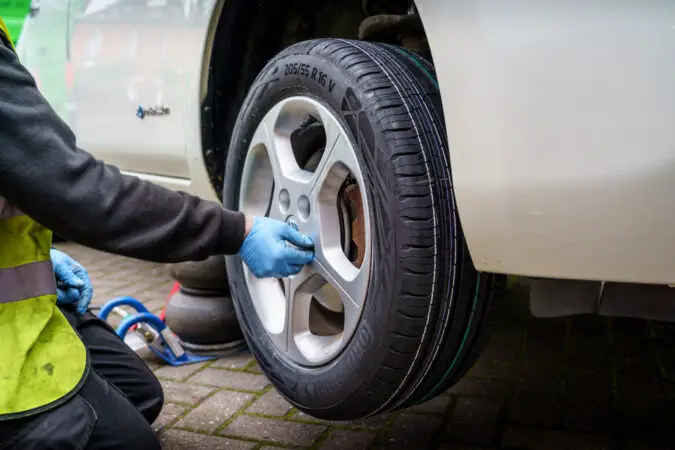Are you thinking about what could happen if you are driving on a flat tire? Well, if that is the case, then you are at the right place because, in this article, there will be quite a lot to cover.
Doing your own research on a possible problem before the problem occurs is always a smart idea. You just don’t want to end up stranded in the middle of the road for a flat tire. Being prepared for a possible problem is always a smart idea.
This is why you need to do your own research and figure out what you can do. Because if you get a flat tire in the middle of the highway, you will nothing else to do than wait for the tow and get your car towed.
And towing is expensive, it will cost you a ton of money, as much as fixing 10 flat tires with the cost of a tire patch or even more in some cases. So, if you don’t want this to happen, pay close attention. First, we are going to learn what is the situation of driving on a flat tire and we will learn the types of flat tires.
After that, we will learn more about the causes of getting flat tires and once we clear that out of our way, we will learn more about driving on a flat tire and what can you expect, and how to prevent it. So, if you want to learn more, follow along.
Flat Tire
Now let’s learn more about what is a flat tire before we cover what is the feel of driving on a flat tire. A lot of people are new to cars or having similar issues and they are not quite yet familiar with tires and what is a flat tire in general. So, let’s further elaborate on this topic and get into the details.
A car as you probably have seen has four wheels. And on each of these wheels, you have a rim. The rim is the metal piece that is bolted onto the car. Rims can be of different sizes and designs. The old-school rims were made out of metal.
But nowadays you have thousands of different designs out there to choose from which are made from aluminum. And rims are probably one of the most sought options when purchasing a new car. And around the rim, you have the tire.
The tires are black and are made out of rubber. And the tire is probably one of the most important components in the drivetrain. Tires have treads and they basically give you the grip that you need.
And as you probably know, tires are inflated with compressed air or nitrogen (speaking of the latter, our write-ups on where to fill your tires with nitrogen, as well as whether can you mix air and nitrogen in your tires). If you get a puncture on the tire treads or on the sidewall, you will get a leak.
This slow leak in the tire will cause the tire to lose air and you will end up in a condition known as a flat tire. And getting a flat tire is not something that you really want since this situation is annoying. But what about driving on a flat tire? More about that, we are going to cover it in a bit. Now let’s take a look at the types of flat tires.
Types Of Flat Tire
Now let’s move on and learn more about the different types of flat tires before we learn how it feels when driving on a flat tire.
Knowing the types will really help you out determine whether or not driving like this is possible or not. So, let’s cover the different types in detail and see more about the different cases that you could come across.
1. Underinflated Tire
The first situation that we are going to cover before driving on a flat tire is the case when you have an underinflated tire. So, what is an underinflated tire?
Well, this is a situation when the tire simply lost pressure over a long time. As you probably know, tires should be topped off with compressed air every month or so.
This is the case because they tend to lose the tire pressure. Every tire does this. So, make sure that you top off the tires regularly. Thus, preventing what does low tire pressure mean. For more context, do check out our guides on a tire pressure sensor fault, as well as what a TPMS sensor does in your car (to learn more, check out our guide on how to reset TPMS).
Because if you don’t, you will end up with underinflated tire. This underinflation can be visible in extreme cases. But in most cases, it will not be noticeable.
In order to get this problem sorted out, just go to your local gas station and top off the tires with compressed air. You can also get a portable air compressor with you as a precaution if you get a flat tire while on the road. But what about driving on a flat tire? More about that, we will discuss it in a bit.
2. Leaky Tire
The second common type of flat tire that we are going to cover before we dive into what is the feeling like driving on a flat tire is the leaky tire. So, what is a leaky tire?
Well, a leaky tire is a tire that tends to leak air more than recommended. As we noted previously, tires can lose pressure over time. But if you have to top off the tire pressure every few days or every day, it means that you have a leak in your tires.
And this leak can be caused by a bent rim or a bad seal between the rim and the tire (thus, necessitating that you consider a bent rim repair cost). Or a puncture, both on the treads or on the tire sidewall. Note, tire sidewall damage can be rather tricky to fix.
And one interesting thing when you have a leaky tire is that in most of these cases, you have a screw or a nail inside of the tire. So, this basically seals the hole but still allows some air to leak out. In these cases, inspecting the tire for puncture is the way to go if you don’t want to end up stranded in the middle of nowhere.
Now let’s continue with the next type of flat tire.
3. Completely Flat Tire
The next type of flat tire that we are going to cover before we learn how it feels when driving on a flat tire is the situation when your tire is completely flat.
Just imagine that you prepare to go to work, and you notice that your tire is completely flat and the car is on the ground.
You try to refill the tire with air and it doesn’t hold air at all. This is the case because the tire has a puncture. More specifically a big puncture.
You have probably a big leak if you went over a sharp object unknowingly while driving the car on the road. Overall, a very bad situation since you are not able to drive the car unless you change the tire with a new one (and learn how to change a tire on a car). But more on that, we are going to cover later on when we will discuss more about driving on a flat tire.
4. Tire Blowout
The last type of flat tire that we are going to cover before we learn more about driving on a flat tire is the tire blowout. So, what is a tire blowout?
Well, this is one of the most common situations that happen on the highway. Usually, the tire at high speeds can explode and this is a situation known as a tire blowout.
And honestly, this is something that you don’t want to experience. Because when you face a situation such as this, you could end up crashing into a different car and ending up in a major collision.
A collision could have potentially deadly outcomes since the speeds on the highway are far above normal town speeds. And on top of that, there could be vehicles around you that can make things even worse for you and for your passengers.
In these situations, the tire sidewall separates from the treads. And instantly, you are losing all the tire pressure. But what could be causing this situation when you have a flat tire? Let’s cover the causes before we dive into what you can do when driving on a flat tire.
Flat Tire Cause
Now that we covered the types of flat tires. Let’s move on and learn more about the causes of this situation before we cover about driving on a flat tire.
Causes are really important when it comes to this problem since you will be able to tell what could be the reason behind the tire losing air or if the tire blows up. So, let’s cover them in detail.
1. Puncture From Road Debris
Now let’s cover the first cause for a flat tire before we dive into how it feels when driving on a flat tire. So, what is the most common reason for this problem?
The most common way to get a puncture is road debris. And trust me, on the road, there is a lot of it, even though we cannot notice it in many cases.
And you can accidentally ride over this debris and cause a puncture on your tire. This could be really dangerous if it happens on the highway.
So, you should definitely beware of road debris. And also, that your tires are not very old. Old tires get punctures a lot more easily than a new set of tires. Changing the tires every 3 to 5 years is the way to go in order to avoid these situations where you get punctures from debris.
But what about driving on a flat tire? More on that, we will cover it in a bit.
2. Overinflating The Tires
The second most common cause of tire puncture that we are going to cover before we learn about driving on a flat tire is tire overinflation. So, what is this situation when it concerns tire inflation?
Overinflation is when you overinflate your tires with compressed air. This means that you put too much pressure on the tire. So, if the pressure from the inside is too much, this will cause structural damage to the tire.
This will make your tires basically tear apart and explode. This a very common situation at high speeds. That’s why you should always recommend the factory-recommended PSI for your car and inflate your tires at the recommended specs.
Since a lot of people are unaware of when they inflate their tires, let’s cover the recommended PSI. If you don’t know PSI stands for Pounds Per Square Inch. And this is a measurement of pressure.
And the right PSI for most tires out there is between 30 and 32 PSI. Still, consult your owner’s manual for the right tire pressure for your car. But what about driving on a flat tire? More on that, we will cover it in a bit.
3. Using Old Tires
The next cause for a flat tire that we are going to cover before we discuss driving on a flat tire is the situation when you use old tires.
Old tires can be really dangerous on the road. If you drive on the highway, you should know that tires get hot at high speeds. And if the heat is too much, it will cause the tire to tear apart.
So, that’s why if your tires are older than 3 years, you should definitely replace them. For most cars, tires are not that expensive after all. But what about driving on a flat tire? More on that, we will cover next.
4. Using Cheap Tires
Another very common cause of a flat tire is using cheap tires. Cheap tires are not the way to go if you are asking me. But beware, there is a difference between budget tires and cheap tires. When we are talking about budget tires, we talk about reputable brands that are somewhat more affordable than the premium tires that you can buy.
But when we are talking about cheap tires, we talk about no-name brands. Some of these are certainly among the worst tire brands that you can buy. So, this is why you should do your research before you buy and read some reviews to find out which ones are the best car tires, the best brands of tires, and the top tire brands out there.
These cheap tires can have problems since the materials that are used to make them are not very good. They can be plasticky and offer a really low grip. Sometimes they even explode. So, having a blowout on the highway is much more probable with these tires. But what about driving on a flat tire? We will get to that in a bit.
5. Overloading The Vehicle
And the last cause for you driving on a flat tire is overloading the vehicle. So, why is this a problem? How can overloading a car can cause the tire to explode?
Well, simple, tires are created to handle enough pressure before exploding. Each tire has a load rating on it and this load rating should be followed unless you want to end up in a situation like this. For more insight, do refer to our write-ups on the tire load range SL, as well as E-rated tires, in addition to the speed rating V vs H.
So, we strongly recommend following these recommendations because you don’t want to end up driving on a flat tire. But let’s say that you have a flat tire, what should you do? Let’s learn more about that next.
Driving On A Flat Tire
Now let’s take a look when it comes to driving on a flat tire. Let’s say that you have a blowout on the highway. What you should do in this situation?
Well, in this situation what a lot of people usually do is slam on the brakes. They get scared and they start to brake. And this is something that you don’t want to do.
These are high speeds and if there is a fast car behind, you could get rear-ended, seriously hurting yourself and the people in the other car.
What you should want to do in this case is to hold the steering wheel really well and control the car. Then slowly if there are not cars behind you, try to turn to the right side of the road where you could safely stop. And also, use your turn indicators since you don’t want people not to be aware of your intentions.
Then after you came to the side of the road, turn your hazards and wait for the tow truck to come. Or if you have a spare wheel, replace the wheel of your car with the donut spare tire. But how does it feel driving on a flat tire? More about that next.
How Does A Car Feel When Driving On A Flat Tire
Another topic that we would like to cover is the feeling that you get when you are driving with a flat tire. How does this feel, when you’re driving with a nail in your tire, for example?
Well, immediately after you get a puncture, you get an adrenaline rush through your body and our safety mechanism activates.
The important thing when you face these types of situations is to react calmly. Don’t let your emotions overwhelm you and make things much worse.
The first few hundred feet might feel a little bumpy from the tire impacting the inner wheel well. So, the tire could slide and the wheel will create sparks on the road.
This situation will make your car very difficult to control. So, holding the wheel steadily is the thing that you really want in these situations.
But how you can prevent driving on a flat tire? Is there something that you can do to avoid these situations? Well, let’s cover more on that in the following chapter.
Preventing Getting A Flat Tire
So, we learned more about driving on a flat tire. Now let’s move on and learn more about how you can avoid this situation on your car. What you can do in order to avoid this problem ever happening to you?
Well, first thing first, you need to maintain the correct tire pressure in your tires (just like the Tesla Model 3 tire pressure), even using something simple like tire pressure gauges. Always follow the recommended numbers and never overinflate the tires (make sure you’re familiar with how to put air in tires at gas station).
The second thing you need to do is to get new tires every 3 to 5 years, or every 50,000 to 60,000 miles. Tires age and they go through a lot of things. So, having new rubber is always more useful and also less prone to puncture. If your tires keep going flat, then you probably are using old tires. So, tire age is the key.
In addition to this, you should always get tires from reputable brands. Also, not every tire is good, read reviews on the specific model before you make a purchase and see what people have to tell about this type of tire. Feedback is key when it comes to getting the right tires.
And lastly, never overload your tires. Overloading the tire and putting more load than the tire can handle can lead to only one thing, driving on a flat tire and also flat tire replacement if the tire destroys itself. And not only that, but you can also expect to replace the rim if the rim gets too damaged.
Driving On A Flat Tire: In Conclusion…
In this article, we have covered quite a bit when it comes to driving on a flat tire. First, we learned what is a flat tire and the different types of tire punctures that you can get.
In the second part of this article, we covered more about the causes of tire punctures and what can happen if you have a puncture on the road and more about driving on a flat tire.
Frequently Asked Questions
Now let’s answer some frequently asked questions.
Can You Drive On A Flat Tire
Technically, yes you can drive on a flat tire. But with considerable damage on the rim, as well as on the chassis of the car. The car will move forward but this situation when the wheel slides on the tarmac will cause wear and the rim will be damaged. You can also damage your oil pan and cause a major oil leak destroying the engine in the process. So, don’t drive on a flat tire.
How Far Can You Drive On A Flat Tire
You can go for a few miles. But considerable damage to the rim and the car’s undercarriage will be done. So, we would definitely recommend avoiding this practice.
Can You Drive With A Nail In Your Tire
Yes, if you have a nail and the tire does not leak air, you can drive. But only drive to the nearest tire repair shop, don’t drive around with this tire that is very unsafe.
How Fast Can You Drive On A Donut
These temporary donut tires are rated for up to 50 mph. And you should not go above this speed. Since they do not offer a lot of grip and cannot be considered safe.
Can You Drive With Low Tire Pressure
Yes, you can drive with low tire pressure. But this will affect the performance of the engine. The car might seem slow to respond. Not to mention that you can damage the tires and also your fuel economy will drop significantly.
How Long Does It Take To Drive A Mile
This depends on your speed. So, if you drive at 1 mph, it will take you 60 minutes to get there. And if you drive at 60 mph, you will get there in 1 minute.





